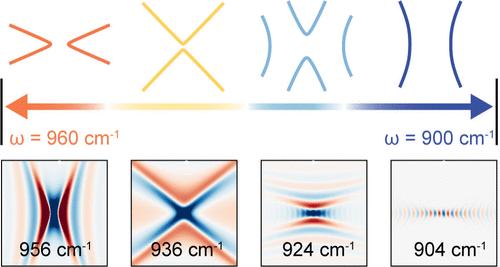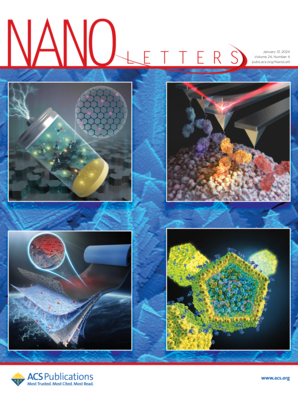Multiple Hyperbolic Dispersion Branches and Broadband Canalization in a Phonon-Polaritonic Heterostructure
IF 9.6
1区 材料科学
Q1 CHEMISTRY, MULTIDISCIPLINARY
引用次数: 0
Abstract
Hyperbolic polaritons in anisotropic crystals hold great promise for guiding the flow of light at deep-subwavelength scales. However, conventional hyperbolic dispersion with a single pair of symmetric branches inherently confines polaritons to propagate only within specific spatial directions. Here we demonstrate a multibranch in-plane hyperbolic dispersion in a phonon-polaritonic heterostructure composed of α-phase molybdenum trioxide (α-MoO3) and 4H-silicon carbide (4H-SiC). Leveraging the in-plane hyperbolicity of α-MoO3 and the interlayer coupling with 4H-SiC, the polaritons manifest distinct dispersive responses along the mutually orthogonal crystal directions of α-MoO3, enabling asymmetric multidirectional polariton propagation. Furthermore, the dispersion contours of polaritons along the [100] crystal direction of α-MoO3 evolves into flat bands as the frequency decreases, yielding broadband polariton canalization in the low-frequency region. These findings deepen our understanding of the evolution of polariton dispersions in α-MoO3/4H-SiC heterostructures and highlight the potential of this phonon-polaritonic heterostructure as a versatile platform for nanolight manipulation.

求助全文
约1分钟内获得全文
求助全文
来源期刊

Nano Letters
工程技术-材料科学:综合
CiteScore
16.80
自引率
2.80%
发文量
1182
审稿时长
1.4 months
期刊介绍:
Nano Letters serves as a dynamic platform for promptly disseminating original results in fundamental, applied, and emerging research across all facets of nanoscience and nanotechnology. A pivotal criterion for inclusion within Nano Letters is the convergence of at least two different areas or disciplines, ensuring a rich interdisciplinary scope. The journal is dedicated to fostering exploration in diverse areas, including:
- Experimental and theoretical findings on physical, chemical, and biological phenomena at the nanoscale
- Synthesis, characterization, and processing of organic, inorganic, polymer, and hybrid nanomaterials through physical, chemical, and biological methodologies
- Modeling and simulation of synthetic, assembly, and interaction processes
- Realization of integrated nanostructures and nano-engineered devices exhibiting advanced performance
- Applications of nanoscale materials in living and environmental systems
Nano Letters is committed to advancing and showcasing groundbreaking research that intersects various domains, fostering innovation and collaboration in the ever-evolving field of nanoscience and nanotechnology.
 求助内容:
求助内容: 应助结果提醒方式:
应助结果提醒方式:


